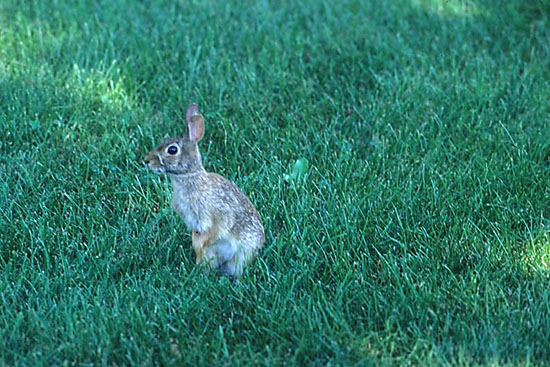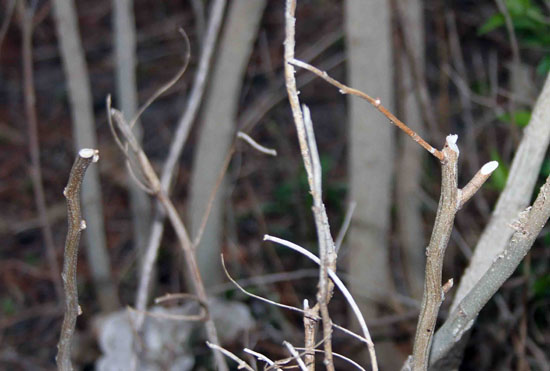Issue 4, May 23, 2017
Rabbit Damage
Peter Rabbit looks so innocent with his little fluffy tail wiggling back and forth. Not to mention Flopsy, Mopsy and Cottontail. But there is garden evil imbedded in his DNA.

Cottontail.
Rabbits are gnawers, loving to eat branches and bark (during the winter) and tender plants during the spring and summer. They'll munch grass down to the crowns, eat developing peony shoots, vegetable transplants, and some bulbous plants like lilies and tulips. They'll occasionally munch on hostas, but most severe hosta damage is usually from deer, which will devour the blade and leave the leaf petiole. Angular cuts or chewing is an indicator of rabbit damage. When feeding on woody twigs close to the ground, their angled cuts looks similar to those made by pruners.

Rabbit damage to hackberry.

Rabbit damage to sumac.
Fruit plants are fair game during winter months, as are most shrubs including barberries, which goes to show the plant's barbs don't really protect the plant from hungry rabbits. Thin barked young trees are also fair game. Rabbits will feed close to the soil surface, and proceed higher on the plant by standing on their hind legs, reaching for the tenderer and less "bark-ier" limbs and buds. Rabbits have the ability to stand on snow, which wasn't a problem in winter 2016-2017 but has been in previous years. Damage usually appears as stripped bark or gnawing on the woody tissue. Bark damage can kill the plant; damage from eating the stems from multi-stemmed shrubs tends to be minimal.
A rabbit may breed up to 5 times per year depending on the environment, with the typical litter consisting of 3 to 6 little ones. If the food source is plentiful, the population explodes.
Exclusion is the best control. A good fence, with at least 6" buried below ground to prevent the rabbit from digging or crawling under, is recommended. Chicken wire or hardware cloth cylinders can be erected around desired plants, again making sure to bury 6". Leave several inches between the wire and the trunk of any tree to prevent the rabbit's teeth from reaching the wood.
Repellents such predator urines, capsaicin (pepper) extracts or castor oil will provide some relief, but you must continue to reapply after rains.
Illinois law prohibits trapping or hunting rabbits out-of-season without permission from the IL Department of Natural Resources. (David Robson)
Author:
David Robson